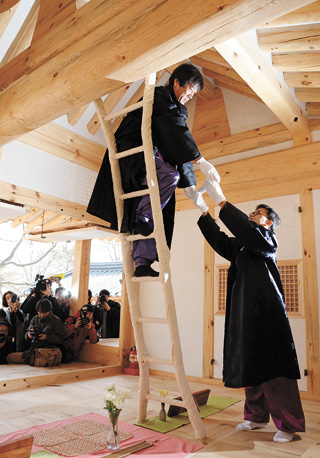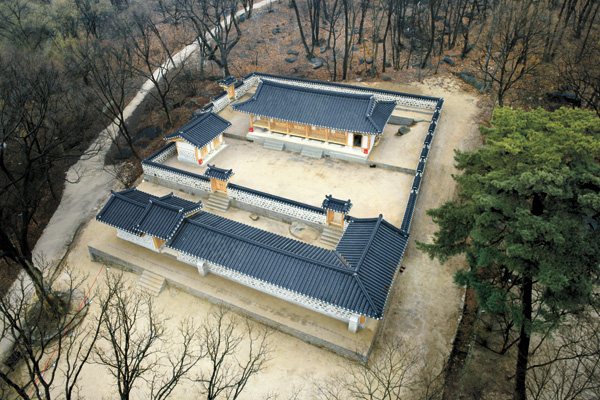Shrine complex is restored to former glory

Officials celebrate the reconstruction the traditional way - by enshrining sangnyangmun, or the text that contains facts about the building.
For King Taejo (1335-1408), the founder of Joseon, she was Queen Sindeok, his second wife.
The state-run Cultural Heritage Administration (CHA) announced last Wednesday that it has reconstructed the shrine complex near Queen Sindeok’s tomb - known as Jeongneung - in Seongbuk District, northern Seoul.
It was customary during Joseon to build such facilities so that descendants could prepare to perform rituals for their dead ancestors.
“We hope through the reconstruction of the shrine complex, Jeongneung’s dignity, history and identity are also restored,” said Choi Gil-seop of the CHA’s royal palaces and tombs division.
The shrine complex in Jeongneung was destroyed when the tomb was moved from Jeongdong, near Deoksu Palace, to its current location in 1409.
In fact, the burial site - one of 40 royal tombs of Joseon on the Unesco World Heritage list - suffered and did not look like a royal tomb for centuries.
Again, the reason for this takes us back to the love between King Taejo and Queen Sindeok.
The tale of how they met is well known in Korea.
The king became thirsty during a hunt and found a well. He asked a woman drawing water from the well to provide him with some. As he was drinking it he found a willow leaf floating in the water and asked the woman why it was there. She replied that she had dropped the leaf in the bowl to prevent him from drinking the water too fast and upsetting his stomach.
The king was impressed by the woman’s wisdom. He was also captivated by her beauty, and he married her. The new queen then gave birth to two sons and a daughter.
Kwon Joon-heung, a researcher at the National Trust for Cultural Heritage, said that, according to unofficial history, King Taejo made Queen Sindeok’s son, Bang-seok, a crown prince instead of one of his first wife’s six sons, “because Queen Sindeok wailed when officials proposed that the king make the eldest son of the first wife a crown prince, and the king cared about her deeply.”
When the queen died, the king buried her close to his residence and even marked where he would be buried when he passed - right next to her.
However, it’s exactly these two factors - how the king loved her dearly and made her son a crown prince -- that caused her tomb to suffer.
Just a year after King Taejo died, King Taejong (1367-1422), the fifth son of the first queen, moved Queen Sindeok’s tomb to the current location, significantly downsizing it and demoting it, in apparent retaliation of the king’s preferential treatment of his stepmother. He also killed the two sons of Queen Sindeok. Needless to say, he didn’t follow his father’s will and did not bury him next to the love of his life.
As a result, Jeongneung did not look like a royal tomb for decades, according to Kwon. Only in 1669 was it partially reconstructed, but its former glory was still nowhere to be seen.
In 2009, the year the tombs were collectively inscribed to the World Heritage list, the CHA conducted an archaeological exploration on the shrine complex site as part of attempts to restore the glory of the tombs and better preserve them.
It discovered building foundations that match a historical record from 1788 on the area. Based on the findings, the CHA completed the restoration, which took three years and 1.5 billion won ($1.4 million).

A view of the reconstructed shrine complex near Jeongneung.
BY KIM HYUNG-EUN [kim.hyungeun@joongang.co.kr]










with the Korea JoongAng Daily
To write comments, please log in to one of the accounts.
Standards Board Policy (0/250자)